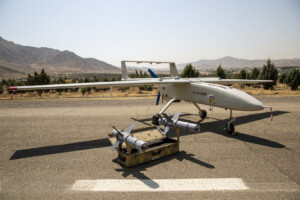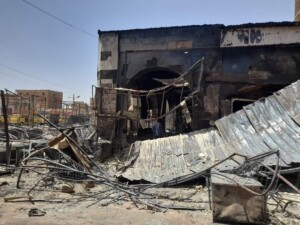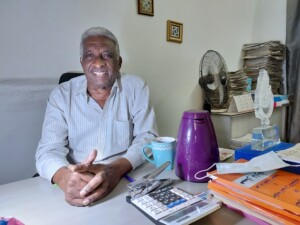Darfur’s East Jebel Marra: Surviving under siege
The continuous attacks and air raids on East Jebel Marra in South Darfur have put most of the population to flight.
An almost complete lack of heath care makes their plight even worse.
By Kamal El Sadig
The continuous attacks and air raids on East Jebel Marra in South Darfur have put most of the population to flight. Some have reached camps for the displaced in the region, while others shelter in the caves and valleys of the Jebel Marra massif. An almost complete lack of heath care makes their plight even worse.
“There is not a single health centre throughout East Jebel Marra; there are no drugs and no health workers,” a doctor laments. He’s sitting under a rakuba sun shade. There is a small table and a rickety chair. He’s examining a small child while the mother looks on.
“I’ve been here for more than four months. I came of my own accord to offer whatever health service I can. I even had to carry the medicines I bought with me secretly, because the government does not allow the entry of anything that would help the people here; not even peanut oil or flour.”
“This huge area has no health service or any kind of humanitarian aid. It completely cut off from the world.”
The doctor says that three children and an elderly woman have died in the month since he arrived: “One child died from cerebral malaria, another of acute malnutrition, and a new born baby from bacterial poisoning. The 60-year-old woman died after suffering a stroke. They all arrived too late. I do not have a vehicle to transfer them to intensive care centres in Nyala or El Fasher.”
The doctor seems very sad as he talks. The child he is examining interrupts him with a cry. There is a long line of other patients waiting outside. “I am sorry, here in Jebel Marra we do not have time, we are very busy, please wait for a moment…”
 The doctor finished examining a malnourished child, he said. “I know that there are hundreds of applications submitted by the UN to allow humanitarian organisations access to East Jebel Marra, but the government refuses to do so, since the expulsion of the French Médecins du Monde, which it was the last one working in the area in 2010.
The doctor finished examining a malnourished child, he said. “I know that there are hundreds of applications submitted by the UN to allow humanitarian organisations access to East Jebel Marra, but the government refuses to do so, since the expulsion of the French Médecins du Monde, which it was the last one working in the area in 2010.
“That happened when the government forces attacked and swept East Jebel Marra, and seized control of some areas such as Deribat. Since then, people here are completely dependent on municipal treatment and ‘vein trees’ as medicine. However, when there are serious cases, people hire vehicles. The cost is around SDG3,500 ($410) for a patient to be taken to Nyala or El Fasher.”
East Jebel Marra, an area with vast mountains, many valleys, and many types of trees, administratively belongs to South Darfur. Located southeast of Deribat and home to around 50,000 people, as the doctor told me, this huge area has no health service or any kind of humanitarian aid. It completely cut off from the world.
“What are the most prevalent diseases here?” I ask.
“I see a lot of malnutrition, malaria, diarrhoea, and respiratory diseases such tuberculosis, and also infections and diseases related to pregnancy, such as anaemia,” he says. “There are also wounds that are not related to the war. Because of the rugged terrain that people must pass on a daily basis, people are injured in falls from the mountains, many fractures and leg injuries.
“The most painful part is that have been no vaccines for children in the last five years. The routine coverage of the vaccination for children in east Jebel Marra is nil. Death among children is very high from malnutrition, diarrhoea, and infections. Since January this year, about 35 children have died in the area between Suni in the west, Leiba in the east, Feina in the south, and Sawani in the north. At least five women have died from complications related to pregnancy. The government went as far as to prevent any commercial vehicle going to East Jebel Marra, except to Deribat, where there has been a military base since 2010.”
“The people here live in rebel-controlled areas, but go farming in the areas under government control.”
The doctor pointed out that most of the population of East Jebel Marra locality live in the rebel-controlled areas. “The entire locality is under control of the Sudan Liberation Movement led by Abdelwahid El Nur, except Deribat and Leiba, over which the government took control in 2010. The population of Deribat and Leiba fled the fighting in that year. There are no people living there anymore, except the soldiers and militiamen at the Deribat military base.”
“The people from Leiba and surrounding villages fled to areas higher in the mountain, where they constructed new villages, such as Arbe, Jaso, Rokona, Tumboul, Sese, Doudo, Baeedkoli, Serbo, Figilo, and Sawani. Every creek or hill in the area has a village built by displaced people, who call the new area Leiba as well,” he explained.
“The people here live in rebel-controlled areas, but go farming in the areas under government control.”
I interject: “Ok, doctor, so where is Unamid?”
'No peacekeepers present'
He laughs for a long time before answering. “In East Jebel Marra, there is no UN peacekeeping presence at all. Unamid and its mission in Darfur have never come here since they first set foot in the region. The situation here as you can see is very bad because of the continuous aerial bombardments which led to the displacement of the local people who fled to the caves in the mountain to save their lives, and to seek shelter from the barrel bombs that are dropped from the aircraft.”
“The government Antonovs drop bombs constantly, especially in areas around Suni where two children were recently killed. Furthermore, all the roads to the eastern side of Jebel Marra are still blocked by the government, to deny access to the UN and other humanitarian organisations. Therefore, there have been no medicines or food supplies to Mount Marra since the start of the military operation in mid-January up to date.”

The Feina village market, toched by militiamen on 20 february 2016 (RD)
He continues: “The government didn't engage in any direct military clashes on the ground with the Sudan Liberation Movement in East Jebel Marra. One month ago, the Sudanese army and janjaweed attacked the area. They looted and burned the market of Feina, and killed one citizen. They left after clashes with the rebels on the second day. The government forces killed 21-year-old man Mohamed El Tahir Adam, and wounded his 18-year-old brother, Eisa El Tahir Adam. The two brothers were on their way back after retrieving two camels which were stolen by the janjaweed, near the village of Kela, west of El Malam.”
Education
The doctor kept silent for a while. I changed the subject and asked him about the children playing over there. They actually reminded me of school. What about education for these children? Are there schools?
He gestured toward the western side, where several children played around some grass-rooved stone karanik [room huts]. “Do you see that building? That is a school built mainly by the efforts of the people of the area, who came together, contributed, and built it. This school actually is one of 14 basic schools and seven secondary schools in the area. 90 percent of the teachers are volunteers from the residents of the area, most of them are university graduates from East Jebel Marra, but they are not employed yet.

The school of Arbe village in East Jebel Marra (RD)
“Their offices are these weakly built rakubas. About 1,000 pupils from East Jebel Marra went to take the final exam from primary school in Mershing. They walked for seven hours to reach the areas where the government allows the movement of public transport, and from there to Mershing. They returned the same way unharmed after they did the exam successfully.
“We are now waiting for the return of more than 1,000 secondary school students who went to Nyala to sit the Sudanese national exam. We wish them a safe return.”
“Yes, we wish them a safe homecoming,” I echoed him, “but when will this blockade end so that the situation can be changed?”
“I do not know for how long,” he says. “How long will the international community keep so silent about the suffering of civilians in Jebel Marra? And all of the civilians in these mountain caves, far away from their homes and in fear of aerial bombardments? The worst part is the health situation, which is very serious here.
“Besides, there is not a single international humanitarian organisation able to reach the people in East Jebel Marra.”

Rokona village in East Jebel Marra (RD)
The conflict in Darfur
Darfur is largely disrupted by armed conflicts. In April 2003, rebels took up arms and rose up against the government, accusing it of neglecting the Darfur region. The government responded with a counter-insurgency campaign, that spilled over to the rest of Darfur and Chad in 2004 and 2005. Civilians have come under attack from army troops, the Sudanese Air Force, government-backed militias, and rebel groups since then.
In 2009, the outgoing military commander of Unamid said the conflict was effectively over. But fighting escalated in 2010, forcing tens of thousands more to flee their homes. This year, over 2.6 million people remain displaced from their homes in Darfur, according to international organisations. As of 20 March, an estimated 129,200 people in the Jebel Marra area were displaced by a major offensive launched by the government on rebel strongholds in the area since 15 January.

The people of Arbe village building the school (RD)

Arbe village in East Jebel Marra (RD)
 A child with diphtheria visiting the doctor. No vaccinations took place since 2010 (RD)
A child with diphtheria visiting the doctor. No vaccinations took place since 2010 (RD)
Also in Features:
Surviving the Antonovs in Darfur












 and then
and then